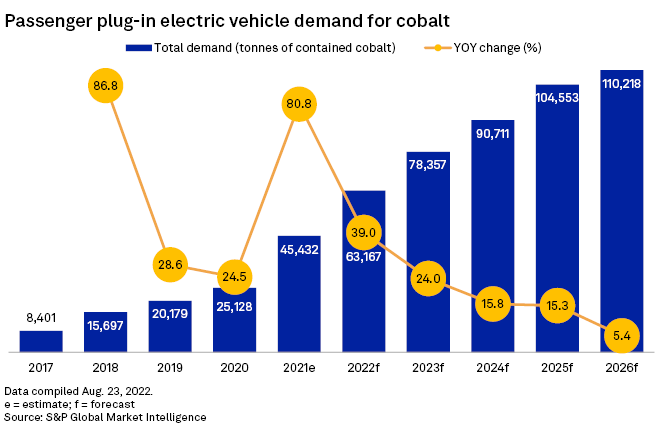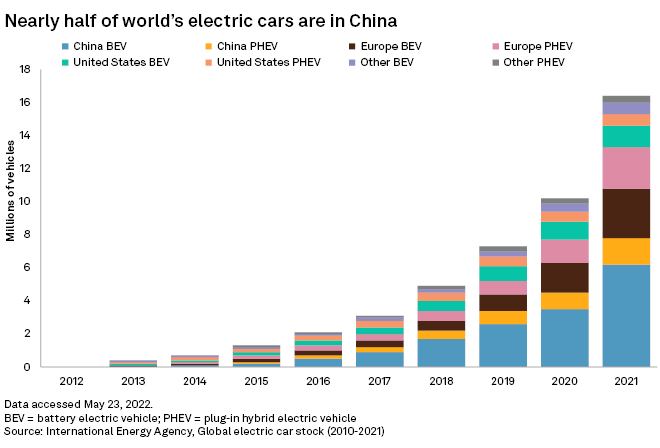S&P Global Offerings
Featured Topics
Featured Products
Events
S&P Global Offerings
Featured Topics
Featured Products
Events
S&P Global Offerings
Featured Topics
Featured Products
Events
Featured Products
Ratings & Benchmarks
By Topic
Market Insights
About S&P Global
Corporate Responsibility
Culture & Engagement
Investor Relations
Featured Products
Ratings & Benchmarks
By Topic
Market Insights
About S&P Global
Corporate Responsibility
Culture & Engagement
Investor Relations
S&P Global Offerings
Featured Topics
Featured Products
Events
Language

As the war in Ukraine continues, many are turning to electric vehicles as a solution to price surges amid the rise in sanctions against Russia. This push for EVs, however, comes with its own set of challenges as metal prices skyrocket and battery supply chains face pressure from the invasion.
Published: April 11, 2022
Updated: Sept. 5, 2022



Subscribe to start every business day with our analyses of the most pressing developments affecting markets today, alongside a curated selection of our latest and most important insights on the global economy.
SUBSCRIBE TO THE NEWSLETTERSElectric vehicle battery-makers are reducing the amount of cobalt in their products in an effort to cut costs and avoid the stigma of buying a product fraught with troubling labor practices. But cobalt demand will soar anyway, thanks to the sheer volume of rising electric vehicle sales.
EVs will be a key part of the global drive to decarbonize the economy, and battery-makers face increased scrutiny from customers and investors. That means trying to cut back on purchases from Congo, which has a history of troubling cobalt mining labor practices, but is the world's largest producer of the metal by far. EVs can be made cheaper by reducing the contained cobalt, which is one of the most expensive parts of the battery, with prices jumping to more than $80,000 per tonne in March, according to S&P Global Market Intelligence.
Battery-makers have heavily invested in developing new chemistries that use less cobalt than ever before, reducing their demand for the metal. But global annual passenger plug-in EV demand is expected to grow 127% to nearly 22 million vehicles by 2026, compared to 9.7 million anticipated sales in 2022, according to Market Intelligence data. That surge in demand will likely overwhelm any declines in cobalt demand generated by changing battery chemistries.
"Despite the prevailing transition to lower cobalt cathode chemistries and the growing share of non-cobalt chemistries, the cobalt bearing [nickel-cobalt-manganese] chemistry will remain the dominant chemistry in the foreseeable future," said Andries Gerbens, a physical trader at Darton Commodities. "Furthermore, the sheer absolute growth in EV sales will mean that EV-related cobalt demand will continue to accelerate in the years to come." 
Less cobalt, cheaper batteries
A key motivator for battery manufacturers to move away from cobalt is the high cost compared to other battery inputs. Cobalt prices have exceeded $50,000/t in 2021 and 2022, spiking to $82,840/t in March 2022, according to Market Intelligence data
Musk Sees Continued Oil and Gas Role, Plays Down EV Battery Metal Sourcing Issue
Tesla CEO Elon Musk on Aug. 29 stressed the continued role of the oil and gas sector in ensuring a functioning "civilization" for humanity, while playing down concerns over the availability of metals needed for batteries in electric vehicle growth.
Read the ArticleInvestment in Lithium-Ion Batteries Could Deliver 5.9 TWh Capacity by 2030
The transition to electromobility plays a leading role in reducing carbon emissions and achieving carbon neutrality. The long-term switch from internal combustion engines to plug-in electric vehicles is boosting demand for traction lithium-ion batteries.
READ THE FULL ARTICLEAlmost Half of Tesla EVs Produced in Q1 Had No Nickel, Cobalt in Battery
Electric vehicle maker Tesla equipped almost half of the EVs manufactured in the first quarter of 2022 with nickel and cobalt-free lithium iron phosphate, or LFP, batteries, it said in its first-quarter results presentation April 20.
READ THE FULL ARTICLEGraphite Emissions Fuel Search for Solutions Along EV Supply Chain
Production of graphite, the largest component of electric vehicle batteries by volume, relies on petroleum coke and other fossil fuels, creating a dilemma for carmakers pushing EVs as a zero-carbon transportation solution.
READ THE FULL ARTICLEListen: Battery Pack Costs on the Rise: Will It Slow Down EV Adoption?
LISTEN AND SUBSCRIBE
The S&P GSCI Electric Vehicle Metals seeks to measure the performance of the tradeable metals used in the production of an electric vehicle (EV) and is designed to have the flexibility to respond to changes in EV technology and the adoption of new metals futures contracts.
LEARN MOREAutomakers do not have enough metal to meet demand for electric vehicles, even as customers facing high fuel prices clamor for more. 
Battery Metals Mining, Recycling Both Critical To Energy Transition: Panel
With the sheer volume of battery terawatt-hours required to transition the world away from fossil fuels, it is going to require both increased mining and advances in battery recycling to meet demand, a panel of battery industry researchers and executives said March 29.
A complete transition to electric transportation will require on the order of 10 TWh of battery production in the next decade, according to Vineet Mehta, director of battery technology and system architecture at Tesla. Taken a step further, to think about getting the entire planet off of fossil fuel consumption, including primary energy consumption, will put total demand close to 350 TWh, Mehta said while moderating a panel at Cambridge EnerTech's International Battery Seminar and Exhibit.

U.S. gasoline prices surging above $4.00/gal on average are making EVs—already coming off a record market share of 6% in the fourth quarter of 2021—even more financially attractive to drive, say vehicle trade groups.
Charging an EV costs one-fifth to one-half of refueling a comparable gasoline internal combustion engine (ICE), on a per-mile basis, in the U.S., said the Zero Emission Transportation Association (ZETA) in a report released in early March.
Comparing models of popular SUVs, pickups, and sedans, ZETA said that the EVs are significantly less costly to drive in each category. The prices below are based on a retail gasoline price of $4.32/gal (as of 10 March) and a $0.14/KWh for power (December 2021).
"This month's Consumer Price Index shows once again that gas prices are surging, which has been exacerbated by Putin's invasion of Ukraine. American families are losing money at the pump to a commodity that is increasingly unpredictable and unaffordable in an already-expensive pandemic year," said Joe Britton, executive director of ZETA. "Our analysis shows that American consumers don't have to choose between driving their car or saving money. Electric vehicles are affordable now."
However, ICE engines still offer substantial advantages on driving range. 
How will consumers react?
Volatile gasoline prices do make EVs more attractive to consumers, commented Mike Fiske, research and analysis director at S&P Global Mobility. "The larger question is whether consumers view this spike in cost as being temporary or not," he said in an email to Net-Zero Business Daily by S&P Global Commodity Insights.
China's Lithium Consumption to Slow in April as Pandemic Curbs Disrupt Demand
China's lithium consumption is expected to slow down slightly in April from March amid high raw material prices and pandemic-led disruptions, industry sources said March 14.
READ THE FULL ARTICLEElectric Vehicle Shortage Will Drive Carmakers To Invest – Volta Energy CEO
Automakers and battery manufacturers will not be able to keep up with the pace of electric vehicle demand at first, but that will only encourage legacy automakers to double down on making necessary investments in new technology.
READ THE FULL ARTICLEEV Take-Up To Fall Short Of Forecasts On Russia-Ukraine Crisis: Miner Sibanye-Stillwater
Battery electric vehicle penetration rates will probably be lower than most forecast in the medium to long term due to consequences of the Russia-Ukraine crisis, Neal Froneman, CEO of South African-based platinum group metals and gold producer Sibanye-Stillwater said March 17.
READ THE FULL ARTICLENickel Price Spike During Russia-Ukraine Conflict Could Drive Up EV Costs
Nickel prices jumped after Russia, a top global nickel producer, invaded Ukraine on Feb. 24, threatening to drive up electric vehicle battery costs that were already under pressure from rising raw material prices.
READ THE FULL ARTICLE
From weekly one-minute observations about industry trends to more in-depth discussions on automotive disruption, innovation and the strategic implications, our podcasts will give you the latest insights straight from our experts.
LISTEN AND SUBSCRIBEChina maintained its vast dominance in the global electric vehicle market by selling a record 3.3 million cars in 2021, while the U.S. ended a two-year slump to see EV sales double, according to newly released data.
Worldwide EV sales doubled year over year in 2021 to 6.6 million, the International Energy Agency reported in its Global EV Outlook for 2022 on May 23. Some 630,000 plug-in battery and hybrid electric cars were sold in the U.S. in 2021, twice as many as the year before. In Europe, 2.3 million EVs were sold.
In all, there were 16.5 million electric cars on the road worldwide in 2021, three times more than in 2018, the agency reported. The IEA and many nations are looking to EVs to replace combustion engines to slow climate change. In the U.S, transportation is the largest source of carbon dioxide emissions, accounting for 33% in 2020. 
The National Oceanic and Atmospheric Administration reported separately on May 23 that greenhouse gas emissions from human activities trapped 49% more heat in 2021 than in 1990, the baseline year for the initial Kyoto climate protocol.
But so far, EV production and uptake have been dominated by China and the EU. Those two regions accounted for 85% of the world's sales in 2021, the IEA said.
European governments plowed the equivalent of $12.5 billion into EV subsidies and tax waivers in 2021, and China $12 billion, the agency's report found.
Solar Cells Anchor Growing Industrial Silver Demand, While EVs Offer Opportunity: Analyst
The photovoltaic (PV) cell market for solar energy panels continued to anchor a 9% year-over-year increase in global silver demand for industrial applications in 2021, and electric vehicles present an opportunity for further gains over the coming years, according to Metals Focus Managing Director Philip Newman.
READ THE FULL ARTICLEGoing Electric: Introducing The S&P GSCI Electric Vehicle Metals
As the world has begun to focus on new technology to aid in the global energy transition, electric vehicles (EV) are becoming more a part of everyday life.
Read the ArticleGeneral Motors To Launch Canada's First Commercial Electric Vehicle Hub In Ontario
General Motors will launch Canada's first full-scale commercial electric vehicle manufacturing hub at its CAMI automotive assembly plant in Ingersoll, Ontario, with production expected to begin by the end of the year, the company said April 4.
READ THE FULL ARTICLETalkingPoints: S&P GSCI Electric Vehicle Metals - Commodities Go Electric
As the world has begun to focus on new technology to aid in the global energy transition, electric vehicles are becoming more a part of everyday life.
READ THE FULL ARTICLE
Energy transitions present major strategic decision-making challenges for today's business leaders. Gain a comprehensive view of where the move to sustainable energy is and where it’s headed with S&P Global Commodity Insights Energy Transition.
LEARN MORE

